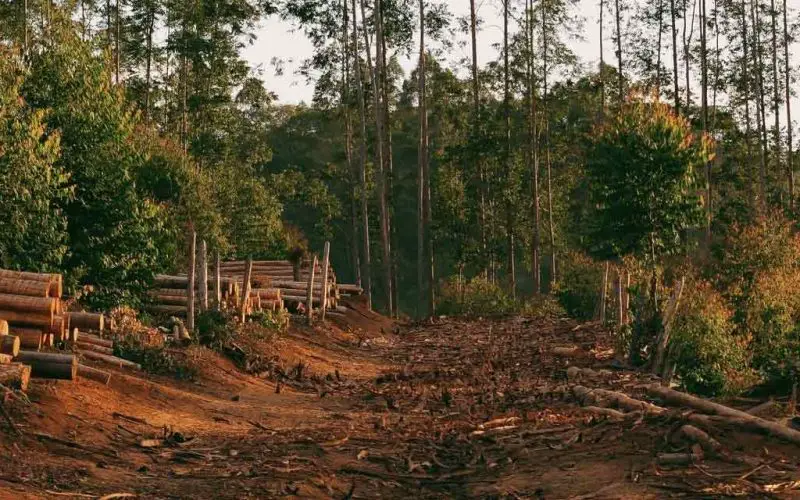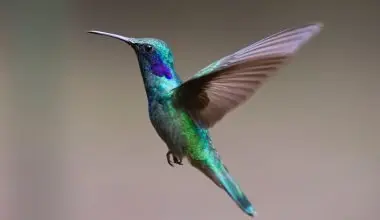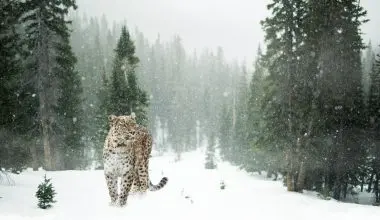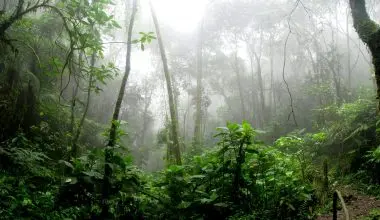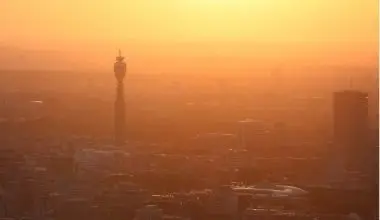Table of Contents Show
[Updated: 11 July 2020]
To give you an idea of what deforestation does to animals. I’d like you to see the featured image above.
It’s a forest cleared to make way for a road being built through a forest. This is a classic example of Habitat Fragmentation.
Do you see animals here? Nope
If that hint wasn’t enough let’s dive more into detail of causes, effects and solutions to deforestation.
The earth is covered with forests which host a wide and diverse community of plants and organisms. 31 percent of the earth is roughly covered with forest and about 80 percent of the world’s biodiversity is housed in this forest ecosystem.
Navigation:
Causes of Deforestation (Why is deforestation happening?)
Forests Most Affected by Deforestation
Effects of Deforestation on Animals
Forests are an important asset to the planet and all the living organisms, if these forests stopped existing or if the count of these forests decreased significantly, it would become impossible for us to survive.
This brings us to the problem of deforestation, a leading cause of climate change to which most of the world’s powerful economies have turned a blind eye in order to profit off of this process.
What is Deforestation?
Deforestation is the removal of trees by humans. It is estimated that if we continue to remove trees at the current rate as of today, we will have no forests on the earth within 100 years.
So why is deforestation happening? / Why do we cut trees?
Well there are many causes of deforestation and no single reason can be solely highlighted.
1. Urbanization
Forests are usually cut to make way for developmental projects so that people may live with comfort. As the population of our planet is drastically increasing, forests have to be chopped down to make way for roads, houses, apartments and expansions of cities.
2. Agriculture
The logging industry also contributes to deforestation as forests are being cut for development without any regulations in place to control the rate of logging.
Farmers and cattle grazers are also responsible for deforestation as farmers require land to carry out agriculture to grow crops and make a living, whereas the animal grazing in these lands lead to loss of plants and greenery in the region and also reduces the fertility of the soil due to soil erosion.
Soil erosion is much more an issue in rainforests, where the land is more vulnerable to clear-cutting. Clear-cutting is basically removal of all trees from an area.
3. To stabilize national economy
Deforestation is also occurring to benefit the economies of various developing and developed countries around the world.
Countries which are in debt export their natural resources to the world in order to fight off poverty, debt and reduce inflation in the country. This way they are able to stabilize their economy.
Many developing countries are forced to practice agriculture to fight poverty in the region.
In order to carry out agriculture, forests have to make way which contributes largely to the reason why deforestation is taking place in those countries. The countries with highest rates of deforestation include Brazil, Russia, Indonesia, Peru, Mexico and many more.
The forests most affected by deforestation are:
- The Amazon rainforest
- The Sumatran rainforest
- British Columbia rainforests in Canada
These are the most severely affected forests around the world. Most of the deforestation which is occurring in these regions is due to human benefits.
For example, rainforests of The British Columbia are home to the best lumbar in the world. Its sold around the world to manufacture products such as furniture.
Effects of deforestation on animals
Deforestation has many detrimental effects on animals. Some of which have been discussed below.
1. Loss of Habitat
Habitat is necessary for all animal or plant species to successfully be able to carry out its life cycles (grow and reproduce).
Deforestation unfortunately destroys habitats making it very difficult for animals to live. Forests are a source of food and shelter for animals and once there are no available forests to live; they are at risk of being hunted down, dying out from starvation or not being able to live long enough to reproduce.
The remaining habitat little available to them is fragmented and surrounded by areas used by humans for various purposes like agriculture.
Small or fragmented habitats may no longer be suitable to maintain a large population of a particular animal and the small population may have trouble breeding successfully. If breeding does occur, there is a very good chance that the biodiversity will be reduced due to the size of the population in that habitat.
Poaching is also increased as there is limited shelter available for the animals to hide from their predators, thus reducing the population of the species even more. Hunting can also be easily carried out because of the same reason as easier poaching.
The habitat loss is a serious issue for those animals which solely live in forests such as Northern spotted Owl in the Western United States.
So if the forests start to disappear there is an increase likelihood that the species which absolutely rely on them will also start to disappear, and eventually become extinct.
2. Climate Change
The large composition of the forests is based on trees. These trees serve many purposes; one of them is the storage of carbon content and utilization of carbon dioxide in the process of photosynthesis to reduce the greenhouse gas known as carbon dioxide.
However, as the particular process of deforestation is to remove trees, the forests are no longer able to store carbon dioxide and protect the planet from the devastating effect of greenhouse gasses such as carbon dioxide.
The greenhouse gas effect severely alters the climate of the world and is associated with severe change in weather patterns, melting of glaciers, rainfall seasons and temperature fluctuations.
3. Starvation
We previously mentioned that forests provide the animals living in the forests with quite a lot of food to grow and nourish. Once deforestation starts to occur, the number of plants and trees starts to decrease.
Loss of trees makes it very difficult for animals to live properly as one of their major resources of food is taken away from them. Herbivores are the ones affected the most and are the first ones to die of starvation due to deforestation.
This is because herbivores depend on plants for food.
4. Wildfires and Droughts
The remainder of the forest that remains after deforestation becomes more susceptible to wildfires.
This is due to the fact that the number of trees is significantly decreased which released water from their surfaces in the form of water vapors to keep the atmospheric temperature from getting too hot.
When there are no available trees to maintain the temperature and provide shelter, the temperatures rise and increase the likelihood of fires and also droughts.
Droughts can work along with the process of deforestation to significantly reduce the population of the animals. Deforestation also leads to barren lands which have significantly higher temperatures and eventually no livelihood, basically leading to desertification.
5. Increased Interaction with humans
The more deforestation occurs, the greater the chance that animals come in contact with humans. This is because we are going and inhabiting a territory which isn’t originally ours to begin with, so the frequency of interaction increases.
This interaction usually leads to a negative outcome as the animals may attack the humans in the act of self-defense and the same can be said for humans.
Humans may also extensively hunt down some animals which they fear as a threat to their lives if animals live close to towns. This interaction usually may result in a reduction of specific animals from the population.
A little Solution to Deforestation
There are multiple solutions that can be made to reduce deforestation such as restrictions, laws and protests. However, a better way would be to replace the trees cut down everyday by planting more trees everyday.
Suppose if ten trees were cut down in a day, a good idea would be to plant ten more at another place just to replace them. Although they’ll take time to grow but the world won’t just run out of trees this way, right?
This is just a minor article regarding How deforestation Affects Animals. You can read more about deforestation by clicking the link below:
